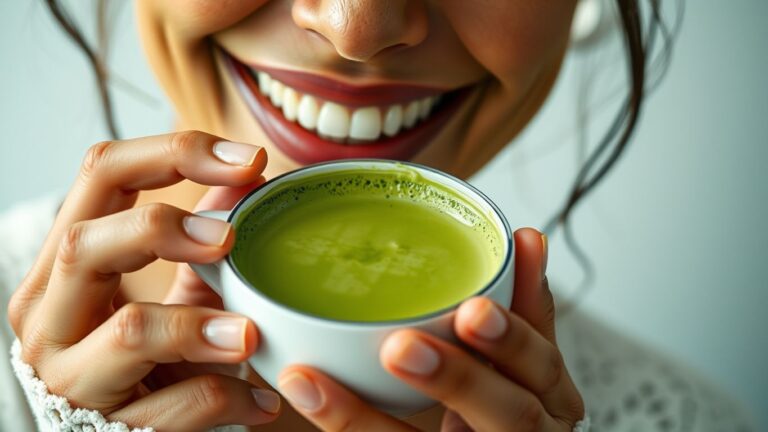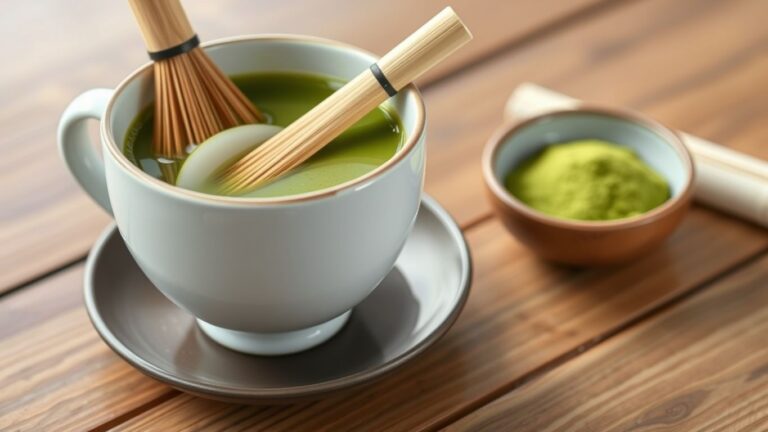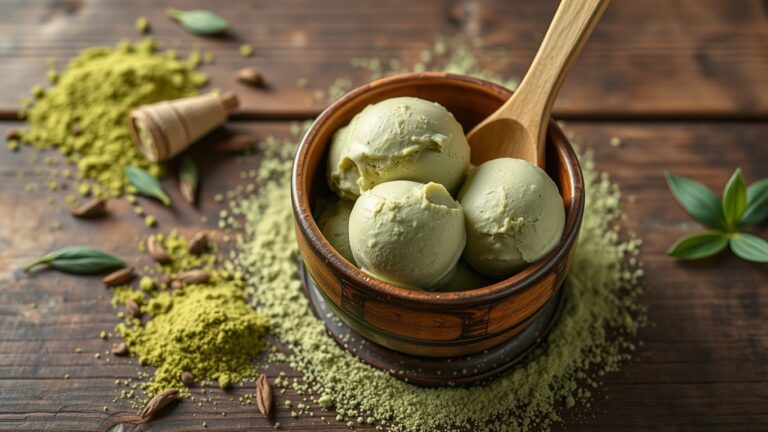Matcha, a vibrant green tea powder, has gained popularity around the world for its unique taste and health benefits. Originating from Japan, matcha is known for its high caffeine content and rich antioxidants. This article dives into everything you need to know about matcha, from its origins and caffeine content to its health benefits and environmental impact.
Key Takeaways
- Matcha is a type of powdered green tea that comes from the Camellia sinensis plant, primarily grown in Japan.
- Matcha contains more caffeine than regular green tea, with levels ranging from 19 to 44 milligrams per gram.
- The way matcha is grown and processed contributes to its high antioxidant content and unique flavor.
- Matcha offers various health benefits, including boosting metabolism, providing antioxidants, and potentially preventing certain diseases.
- Despite its caffeine content, matcha provides a more stable energy boost compared to coffee, thanks to the presence of L-theanine.
Understanding Matcha and Its Origins
What is Matcha?
Matcha is a powdered green tea of Japanese origin. Unlike regular green tea, which is made by steeping leaves in water, matcha involves grinding whole green tea leaves into a fine powder. This means you consume the entire leaf, getting more nutrients and flavor.
How Matcha is Made
The process of making matcha starts with growing the tea plants in shaded areas. This increases their chlorophyll and amino acid content. The leaves are then harvested, steamed, dried, and ground into a fine powder. This traditional method has been perfected over centuries.
Historical Background of Matcha
Matcha was introduced to Japan in the 1100s by way of China. It quickly became popular among Japanese tea connoisseurs and was integrated into the Japanese tea ceremony. Today, matcha is enjoyed worldwide for its unique flavor and health benefits.
Matcha’s journey from ancient China to modern-day tea shops around the world is a testament to its enduring appeal and versatility.
Caffeine Content in Matcha
How Much Caffeine is in Matcha?
Matcha contains between 18.9 and 44.4 milligrams of caffeine per gram of tea. For a typical serving size of 2-4 grams, this means you could be consuming anywhere from 37.8 to 177.6 milligrams of caffeine. This range is quite broad, so the exact amount depends on how much powder you use.
Factors Affecting Caffeine Levels
Several factors can influence the caffeine content in your matcha:
- The quantity of matcha powder used
- The temperature of the water
- The age of the tea leaves
- The time of harvesting
Using more powder and hotter water will increase the caffeine content, while using less powder or cooler water will decrease it.
Comparing Caffeine in Matcha and Coffee
When comparing matcha to coffee, matcha generally has more caffeine per gram. However, the caffeine content per cup can vary based on preparation methods. Here’s a quick comparison:
| Beverage | Caffeine per Gram | Caffeine per Cup |
|---|---|---|
| Matcha | 18.9-44.4 mg | 75.6-177.6 mg |
| Coffee | 10-12 mg | 80-100 mg |
Matcha can have more caffeine than coffee, depending on how it’s prepared. This makes it a versatile option for those looking to manage their caffeine intake.
Health Benefits of Matcha

Matcha is not just a trendy drink; it offers a range of health benefits that can make a significant difference in your well-being. Let’s dive into some of the key advantages of incorporating matcha into your diet.
Matcha vs. Other Green Teas
Caffeine Comparison
When comparing matcha to other green teas, one of the first things you’ll notice is the difference in caffeine content. Matcha generally has more caffeine than other green teas because you consume the entire tea leaf in powdered form. For example, a typical serving of matcha contains about 68 milligrams of caffeine, while a serving of sencha, a popular green tea, contains about 50 to 60 milligrams.
Nutritional Differences
Matcha and other green teas also differ in their nutritional profiles. Since matcha is made from the whole tea leaf, it retains more nutrients compared to steeped green teas. This means matcha is richer in antioxidants, amino acids, and vitamins. On the other hand, traditional green teas like sencha or gyokuro are steeped, so you only get the nutrients that are water-soluble.
Taste and Preparation
The taste and preparation methods of matcha and other green teas are quite distinct. Matcha has a unique, earthy flavor with a hint of sweetness and a creamy texture. You prepare it by whisking the powder with hot water. Other green teas, like sencha, have a lighter, more delicate flavor and are prepared by steeping the leaves in hot water. This difference in preparation also affects the overall tea-drinking experience.
Though it’s made from the same leaf, some people say matcha is sweeter and creamier than regular green tea. You may also notice a “grassiness” to the smell and taste of matcha, which is less pronounced in other green teas.
How to Prepare Matcha
Traditional Preparation Methods
To make traditional matcha, follow these steps:
- Heat the matcha bowl (chawan) with hot water, swirl it around three times, then discard the water.
- Place one bamboo scoop (chashaku) of matcha into the bowl.
- Sift the matcha powder to prevent clumping.
- Add hot water (not boiling) to the bowl.
- Whisk the mixture with a bamboo whisk (chasen) until it becomes frothy.
Modern Recipes and Variations
Matcha can be enjoyed in various modern ways:
- Matcha Latte: Blend matcha with steamed milk and a sweetener of your choice.
- Coldbrew Matcha: Add matcha to cold water and ice in a shakeable container, then shake vigorously.
- Matcha Smoothie: Mix matcha with fruits, yogurt, and a liquid base for a refreshing drink.
Tools You Need
To prepare matcha, you’ll need the following tools:
- Matcha Bowl (Chawan): A ceramic bowl used for traditional preparation.
- Bamboo Scoop (Chashaku): Measures the correct amount of matcha powder.
- Bamboo Whisk (Chasen): Whisks the matcha to a frothy consistency.
- Sieve: Prevents clumping by sifting the matcha powder.
- Electric Frother: An alternative to the bamboo whisk for a creamy texture.
Preparing matcha can be a soothing ritual that enhances your daily routine. Whether you choose traditional methods or modern variations, the key is to enjoy the process and the delicious results.
Effects of Caffeine in Matcha
Energy and Alertness
Matcha provides a calm alertness that lasts longer than coffee. The caffeine in matcha binds with phytonutrients like L-theanine, which slows the body’s absorption of caffeine. This results in a steady energy boost without the spikes and crashes often associated with coffee. You can expect the energy from matcha to last at least three hours, and some people feel it for up to six or seven hours.
Impact on Mood
The L-theanine in matcha helps create alpha waves in the brain, promoting a state of calm and serene alertness. This can help reduce stress and improve your mood. Unlike coffee, which can cause spikes in adrenaline and cortisol, matcha helps stabilize blood sugar levels and reduces stress on the adrenal glands.
Potential Side Effects
While many people tolerate caffeine well, some may experience side effects such as anxiety, jitters, fast heartbeat, nausea, headache, or difficulty sleeping. If you experience any of these symptoms, it may help to drink water, eat food, or take a gentle walk to reduce anxiety. In rare cases, caffeine overdose can occur, leading to severe symptoms like confusion or difficulty breathing. If this happens, seek emergency help immediately.
Matcha contains caffeine, but its unique combination with L-theanine provides a balanced and sustained energy boost, making it a great alternative to coffee.
Matcha for Different Lifestyles
Matcha for Fitness Enthusiasts
If you’re into fitness, matcha can be a great addition to your routine. Matcha is packed with antioxidants and can help boost your metabolism. This means you can get more out of your workouts. Plus, the caffeine in matcha provides a steady energy boost without the crash, making it perfect for pre-workout.
Matcha for Busy Professionals
For those with a hectic schedule, matcha offers a quick and easy way to stay energized throughout the day. Unlike coffee, matcha provides a more sustained energy release, helping you stay focused and alert. You can easily prepare a cup of matcha in the morning and enjoy its benefits all day long.
Matcha for Relaxation
Matcha isn’t just for energy; it can also help you relax. The amino acid L-theanine found in matcha promotes relaxation without drowsiness. This makes it an excellent choice for unwinding after a long day. Whether you prefer it hot or cold, a cup of matcha can be a soothing part of your evening routine.
Choosing the Right Matcha

Grades of Matcha
When selecting matcha, it’s important to understand the different grades available. The two main types are ceremonial and culinary. Ceremonial grade is the highest quality and is best for traditional tea ceremonies. Culinary grade, on the other hand, is perfect for cooking and making lattes.
What to Look for When Buying
When buying matcha, look for a vibrant green color, which indicates freshness and quality. The texture should be fine and smooth, not gritty. Always check the origin; the best matcha comes from Japan. Reading reviews and asking experts, like chefs and tea professionals, can also help you find the best matcha powders.
Storing Your Matcha Properly
To keep your matcha fresh, store it in an airtight container in a cool, dark place. Avoid exposure to light, heat, and moisture. Some people even keep their matcha in the refrigerator to extend its shelf life.
Choosing high-quality matcha elevates your experience while indulging in all the benefits of tea drinking.
Incorporating Matcha into Your Diet

Daily Consumption Recommendations
To enjoy the benefits of matcha, it’s best to consume it in moderation. Experts suggest drinking 1-2 cups per day. This amount provides a good balance of nutrients without overloading on caffeine.
Creative Ways to Use Matcha
Matcha is incredibly versatile and can be added to various recipes:
- Combine matcha with turmeric in a tea or latte.
- Stir it into milk-based foods and drinks, such as lattes or rice pudding.
- Try it in desserts, such as matcha ice cream or cookies.
- Whip up protein smoothies to boost the nutrient content of your favorite recipes.
There are many ways to prepare matcha, so you can choose the one you like best. It can also be incorporated into a range of different recipes.
Potential Dietary Restrictions
While matcha offers numerous health benefits, it’s important to consume it in moderation. Matcha contains more caffeine than regular green tea, which can have adverse effects if consumed in large amounts. Additionally, some people may be sensitive to the catechins in matcha, which could potentially cause liver problems. To be safe, opt for certified organic varieties to reduce the risk of impurities.
Environmental Impact of Matcha Production
Sustainable Farming Practices
Traditional Japanese matcha farming is a very sustainable practice. Farmers use methods that cause no known damage to soil, surrounding lands, water, animals, or air. This approach ensures that the environment remains healthy and productive for future generations.
Environmental Benefits
Matcha farming offers several environmental benefits. For instance, the shade-grown method used in matcha cultivation helps in carbon sequestration, which can reduce greenhouse gases. Additionally, organic farming practices often used in matcha production help maintain biodiversity and soil health.
Challenges in Matcha Cultivation
Despite its benefits, matcha cultivation faces several challenges. Climate change poses a significant threat, as it can affect the quality and yield of matcha. Moreover, the labor-intensive nature of traditional farming methods can make it difficult to scale up production sustainably.
In summary, traditional Japanese matcha farming is a very sustainable practice, but it faces challenges like climate change and labor intensity. Sustainable practices and organic farming can help mitigate some of these issues.
Common Myths About Matcha

Debunking Caffeine Myths
One common myth is that matcha has no caffeine. In reality, matcha does contain caffeine, but it is released more slowly into your system compared to coffee. This means you get a longer period of alertness without the crash.
Clarifying Health Claims
Another myth is that matcha is a miracle cure for weight loss. While matcha can help boost your metabolism and aid in fat burning, it is not a magic solution. It’s important to combine matcha with a balanced diet and regular exercise for the best results.
Understanding Quality Differences
Many people believe that all matcha is the same. However, there are different grades of matcha, each with its own quality and flavor profile. Ceremonial grade matcha is the highest quality and is best for traditional tea ceremonies, while culinary grade matcha is more suitable for cooking and baking.
Conclusion
Matcha is a unique and vibrant green tea that offers a notable caffeine boost, often higher than regular green tea but typically less than coffee. Its caffeine content can vary based on factors like the quality of the leaves and how it’s prepared. While matcha provides a steady and calm energy lift, thanks to its combination of caffeine and L-theanine, it’s also packed with antioxidants that offer numerous health benefits. Whether you’re looking for an alternative to coffee or just want to enjoy a delicious and healthful drink, matcha is a great choice. Just remember to enjoy it in moderation to avoid any potential downsides of too much caffeine.
Frequently Asked Questions
Does matcha have caffeine?
Yes, matcha contains caffeine. It usually has more caffeine than regular green tea but less than coffee.
How much caffeine is in a cup of matcha?
A cup of matcha typically contains about 70 mg of caffeine. This amount can vary based on how much powder you use and how it’s prepared.
Is the caffeine in matcha different from coffee?
Yes, the caffeine in matcha is absorbed more slowly, leading to a more steady energy boost without the jitters or crash often associated with coffee.
Can I drink matcha every day?
Yes, you can drink matcha daily. Most people can safely consume 2-3 servings per day, but it’s always best to listen to your body and consult with a healthcare provider if you have concerns.
What are the health benefits of matcha?
Matcha is rich in antioxidants, which can help protect your cells. It may also boost metabolism, improve mood, and support overall health.
How do I prepare matcha?
To prepare matcha, sift 1-2 grams of matcha powder into a cup, add a small amount of hot water, and whisk until frothy. Then, add more hot water or milk, depending on your preference.
Is matcha better than regular green tea?
Matcha contains more nutrients and antioxidants compared to regular green tea because you consume the whole leaf. It also has a higher caffeine content.
Can matcha help with weight loss?
Matcha may help with weight loss by boosting metabolism and increasing fat burning. However, it should be part of a balanced diet and healthy lifestyle.






